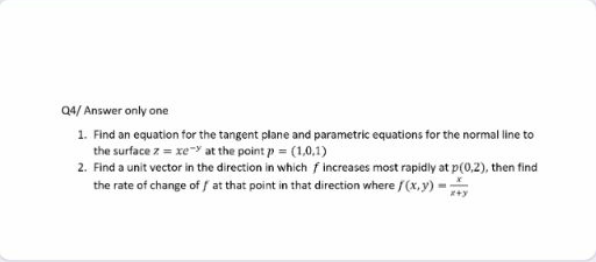
Question Number 115201 by mohammad17 last updated on 24/Sep/20

Commented by mohammad17 last updated on 24/Sep/20

$${help}\:{me}\:{sir}\:{please} \\ $$
Answered by 1549442205PVT last updated on 24/Sep/20

$$\mathrm{Q4} \\ $$$$\left.\mathrm{1a}\right)\mathrm{The}\:\mathrm{equation}\:\mathrm{of}\:\mathrm{tangent}\:\mathrm{plane}\:\mathrm{at} \\ $$$$\mathrm{P}\left(\mathrm{1};\mathrm{0};\mathrm{1}\right)\:\mathrm{for}\:\mathrm{the}\:\mathrm{function}\:\mathrm{z}=\mathrm{xe}^{−\mathrm{y}} \:\mathrm{is}: \\ $$$$\mathrm{z}−\mathrm{z}_{\mathrm{0}} =\left(\frac{\partial\mathrm{z}}{\partial\mathrm{x}}\right)_{\mathrm{P}} \left(\mathrm{x}−\mathrm{x}_{\mathrm{0}} \right)+\left(\frac{\partial\mathrm{z}}{\partial\mathrm{y}}\right)_{\mathrm{P}} \left(\mathrm{y}−\mathrm{y}_{\mathrm{0}} \right) \\ $$$$\Leftrightarrow\mathrm{z}−\mathrm{1}=\mathrm{1}.\left(\mathrm{x}−\mathrm{1}\right)+\left(−\mathrm{1}\right)\left(\mathrm{y}−\mathrm{0}\right) \\ $$$$\Leftrightarrow\mathrm{z}−\mathrm{1}=\mathrm{x}−\mathrm{y}−\mathrm{1}\Leftrightarrow\mathrm{x}−\mathrm{y}−\mathrm{z}=\mathrm{0} \\ $$$$\left.\mathrm{b}\right)\mathrm{The}\:\mathrm{equation}\:\mathrm{of}\:\mathrm{the}\:\mathrm{normal}\:\mathrm{line}\:\:\mathrm{is} \\ $$$$\frac{\mathrm{x}−\mathrm{x}_{\mathrm{0}} }{\left(\frac{\partial\mathrm{z}}{\partial\mathrm{x}}\right)_{\mathrm{P}} }=\frac{\mathrm{y}−\mathrm{y}_{\mathrm{0}} }{\left(\frac{\partial\mathrm{z}}{\partial\mathrm{y}}\right)_{\mathrm{P}} }=\frac{\mathrm{z}−\mathrm{z}_{\mathrm{0}} }{−\mathrm{1}} \\ $$$$\Leftrightarrow\frac{\mathrm{x}−\mathrm{1}}{\mathrm{1}}=\frac{\mathrm{y}−\mathrm{0}}{−\mathrm{1}}=\frac{\mathrm{z}−\mathrm{1}}{−\mathrm{1}}=\mathrm{t}\:\mathrm{or}\:\mathrm{in}\:\mathrm{the}\:\mathrm{form} \\ $$$$\mathrm{of}\:\mathrm{the}\:\mathrm{parameter}: \\ $$$$\begin{cases}{\mathrm{x}=\mathrm{t}+\mathrm{1}}\\{\mathrm{y}=−\mathrm{t}}\\{\mathrm{z}=−\mathrm{t}+\mathrm{1}}\end{cases} \\ $$$$\left.\mathrm{2}\right)\mathrm{The}\:\mathrm{function}\:\mathrm{will}\:\:\mathrm{increase}\:\mathrm{most}\:\mathrm{rapidly} \\ $$$$\mathrm{in}\:\mathrm{the}\:\mathrm{direction}\:\mathrm{of}\:\mathrm{the}\:\mathrm{gradien}\:\mathrm{vector}\: \\ $$$$\mathrm{of}\:\mathrm{the}\:\mathrm{function}\:\mathrm{f}\left(\mathrm{x},\mathrm{y}\right)=\frac{\mathrm{x}}{\mathrm{x}+\mathrm{y}}=\mathrm{1}−\frac{\mathrm{y}}{\mathrm{x}+\mathrm{y}} \\ $$$$\frac{\partial\mathrm{f}\left(\mathrm{x},\mathrm{y}\right)}{\partial\mathrm{x}}=\frac{\mathrm{y}}{\left(\mathrm{x}+\mathrm{y}\right)^{\mathrm{2}} },\frac{\partial\mathrm{f}\left(\mathrm{x},\mathrm{y}\right)}{\partial\mathrm{y}}=\frac{−\mathrm{x}}{\left(\mathrm{x}+\mathrm{y}\right)^{\mathrm{2}} }.\mathrm{Hence} \\ $$$$\mathrm{grad}\:\mathrm{f}\left(\mathrm{x},\mathrm{y}\right)=\frac{\partial\mathrm{f}\left(\mathrm{x},\mathrm{y}\right)}{\partial\mathrm{x}}\mathrm{i}+\frac{\partial\mathrm{f}\left(\mathrm{x},\mathrm{y}\right)}{\partial\mathrm{y}}\mathrm{j}.\mathrm{Therefore}, \\ $$$$\mathrm{the}\:\mathrm{unit}\:\mathrm{vector}\:\mathrm{we}\:\mathrm{need}\:\mathrm{find}\:\mathrm{is}: \\ $$$$\overset{\rightarrow} {\mathrm{e}}=\frac{\mathrm{1}}{\:\sqrt{\left(\frac{\partial\mathrm{f}\left(\mathrm{x},\mathrm{y}\right)}{\partial\mathrm{x}}+\frac{\partial\mathrm{f}\left(\mathrm{x},\mathrm{y}\right)}{\partial\mathrm{y}}\right)^{\mathrm{2}} }}\left(\frac{\partial\mathrm{f}\left(\mathrm{x},\mathrm{y}\right)}{\partial\mathrm{x}}\mathrm{i}+\frac{\partial\mathrm{f}\left(\mathrm{x},\mathrm{y}\right)}{\partial\mathrm{y}}\mathrm{j}\right) \\ $$$$\mathrm{At}\:\mathrm{the}\:\mathrm{point}\:\mathrm{P}\left(\mathrm{0},\mathrm{2}\right)\:\mathrm{we}\:\mathrm{have}: \\ $$$$\frac{\partial\mathrm{f}\left(\mathrm{x},\mathrm{y}\right)}{\partial\mathrm{x}}=\frac{\mathrm{1}}{\mathrm{2}},\left(\frac{\partial\mathrm{f}\left(\mathrm{x},\mathrm{y}\right)}{\partial\mathrm{y}}\right)_{\left(\mathrm{0},\mathrm{2}\right)} =\mathrm{0} \\ $$$$\overset{\rightarrow} {\mathrm{e}}=\mathrm{i}\Rightarrow\:\alpha=\widehat {\left(\mathrm{e},\mathrm{Ox}\right)}=\mathrm{0}\Rightarrow\mathrm{cos}\alpha=\mathrm{1} \\ $$$$\mathrm{sin}\alpha=\mathrm{0}.\mathrm{Therefore},\mathrm{the}\:\mathrm{rate}\:\mathrm{change} \\ $$$$\:\mathrm{of}\:\mathrm{change}\:\mathrm{of}\:\mathrm{the}\:\mathrm{function}\:\mathrm{equal}\:\mathrm{to} \\ $$$$\mathrm{v}=\left(\frac{\partial\mathrm{f}\left(\mathrm{x},\mathrm{y}\right)}{\partial\overset{\rightarrow} {\mathrm{e}}}\right)_{\left(\mathrm{0},\mathrm{2}\right)} =\left(\frac{\partial\mathrm{f}\left(\mathrm{x},\mathrm{y}\right)}{\partial\mathrm{x}}\mathrm{c}\right)_{\left(\mathrm{0},\mathrm{2}\right)} \mathrm{cos}\alpha+\left(\frac{\partial\mathrm{f}\left(\mathrm{x},\mathrm{y}\right)}{\partial\mathrm{y}}\right)_{\left(\mathrm{0},\mathrm{2}\right)} \mathrm{sin}\alpha \\ $$$$=\frac{\mathrm{1}}{\mathrm{2}}×\mathrm{1}=\frac{\mathrm{1}}{\mathrm{2}} \\ $$$$\mathrm{second}\:\mathrm{way}: \\ $$$$\left(\frac{\partial\mathrm{f}\left(\mathrm{x},\mathrm{y}\right)}{\partial\overset{\rightarrow} {\mathrm{e}}}\right)_{\mathrm{max}\left(\mathrm{0},\mathrm{2}\right)} =\mid\mathrm{grad}\:\mathrm{f}\left(\mathrm{x},\mathrm{y}\right)\mid_{\left(\mathrm{0},\mathrm{2}\right)} \\ $$$$=\sqrt{\left(\frac{\partial\mathrm{f}\left(\mathrm{x},\mathrm{y}\right)}{\partial\mathrm{x}}\right)^{\mathrm{2}} +\left(\frac{\partial\mathrm{f}\left(\mathrm{x},\mathrm{y}\right)}{\partial\mathrm{y}}\right)^{\mathrm{2}} } \\ $$$$=\sqrt{\left(\frac{\mathrm{1}}{\mathrm{2}}\right)^{\mathrm{2}} +\mathrm{0}^{\mathrm{2}} }=\frac{\mathrm{1}}{\mathrm{2}} \\ $$
